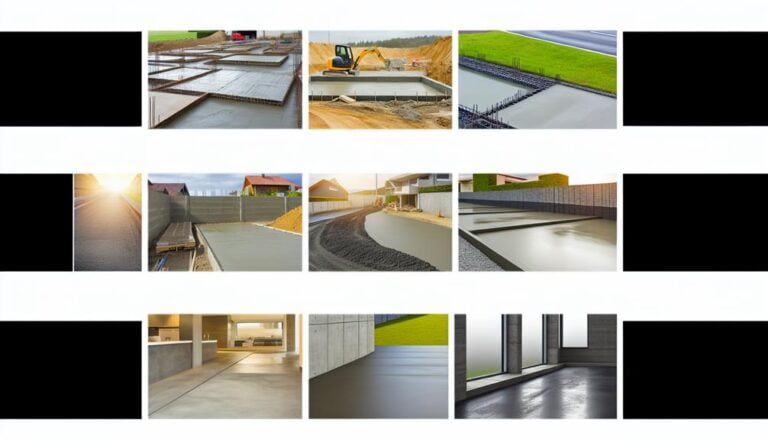Benefits and Applications of Concrete Leveling in Construction
Concrete leveling in construction offers you numerous benefits. It swiftly fixes uneven surfaces and boosts safety by removing trip hazards. You'll appreciate how it extends the life of your concrete, saving you time and labor costs. Noticeably, it also enhances structural integrity and endurance against heavy use. Plus, it ups the aesthetic appeal, increasing your property's value. It's even eco-friendly, reducing waste and carbon footprints. Stick around, you're just scratching the surface of how concrete leveling can revolutionize your construction project. There's a lot more to discover!
Understanding Concrete Leveling
To fully grasp the concept of concrete leveling, you need to understand its fundamental purpose and the process involved. It's a technique used in construction to fix uneven concrete surfaces. It's not just about aesthetics; it's about safety and structural integrity too.
Imagine walking on a sidewalk or a parking lot that's uneven. You'd probably trip, right? That's where concrete leveling comes in. It eliminates trip hazards, prevents water pooling, and extends the life of your concrete.
Now, let's delve into the process. It typically begins with drilling small holes into the uneven concrete slab. Then, a special mixture, often made of cement, sand, and other additives, is pumped into these holes. This mixture, known as a slurry, fills the voids under the slab, raising it until it's level with the surrounding concrete.
And voila! You've got a leveled concrete surface that's not only safe but also looks good. So, whenever you notice an uneven concrete surface, remember concrete leveling. It's a cost-effective solution that'll make a significant difference in the quality of your construction projects. But we'll talk more about its cost-effectiveness in the next section.
Cost-Effectiveness of Concrete Leveling
Now that you're familiar with how concrete leveling works, let's look at why it's a cost-effective choice for your construction needs. First off, it requires less material and labor. Traditional methods might mean tearing up and replacing the entire slab, but concrete leveling can fix the problem with just a fraction of the material, saving you on costs.
Secondly, the speed of the process is a money saver. The quicker a job gets done, the less you're paying in labor expenses. Concrete leveling can often be completed in just a few hours. That's a big difference compared to the days or weeks more traditional methods could take.
Lastly, the longevity of concrete leveling adds to its cost-effectiveness. This method enhances the durability of the existing concrete structure, reducing the need for frequent and costly repairs. If you're thinking about the long-term expenses, you'll find that concrete leveling is a smart choice.
Improved Safety in Construction
Beyond its cost-effectiveness, concrete leveling significantly boosts safety in construction sites, reducing risks and accidents. Uneven surfaces can lead to tripping hazards, equipment instability, and increased wear and tear. With concrete leveling, you're taking preemptive steps to address these issues. As a result, you're less likely to deal with workplace injuries or damage to expensive equipment.
Concrete leveling is also beneficial in maintaining a clean and organized work environment. It prevents the pooling of water, which can create slippery conditions and foster the growth of harmful molds. By ensuring a level surface, you're essentially eliminating these potential dangers.
Moreover, concrete leveling aids in the proper installation of machinery. With a level base, machinery can be installed correctly, minimizing the chance of malfunctions due to uneven load distribution. This reduces the likelihood of unexpected equipment failure, which can lead to accidents or delays in your construction project.
Durability and Strength Features
Another major benefit of concrete leveling is its impressive durability and strength. When you opt for concrete leveling, you're investing in a solution that will stand the test of time. Here's why:
- Resistance to Wear and Tear: Concrete leveling provides a flat and even surface that can withstand heavy traffic and frequent use. This reduces the need for frequent repairs, saving you time and money in the long run.
- Structural Integrity: With concrete leveling, the structural integrity of the surface is enhanced. This means it can support heavy loads without cracking or buckling. You can rest assured that your structure will be stable and secure.
- Long Lifespan: Concrete surfaces that have been leveled have a significantly longer lifespan compared to those that haven't. This is because leveling eliminates irregularities and potential weak spots where damage could occur.
Concrete Leveling and Aesthetics
With concrete leveling, you're not just getting a durable and sturdy surface, but also an aesthetically pleasing one. It has the unique ability to create a smooth, flawless finish that can enhance the look of any structure. Whether it's your home, office, or a public building, concrete leveling can significantly improve its visual appeal.
You'll find that concrete leveling can be tailored to meet your unique aesthetic preferences. You can choose from various colors, patterns, and finishes to match your style. It's not just a grey, dull surface anymore. You can have a polished, colored, or patterned concrete that adds character and personality to your space.
Moreover, concrete leveling can correct uneven surfaces, cracks, and other imperfections that can detract from the visual appeal of the structure. A smooth, level surface is visually appealing and can even increase the value of your property. It's a cost-effective way to enhance the aesthetics of your surroundings without the need for extensive renovations.
Environmental Benefits of Concrete Leveling
Not only does concrete leveling boost the look and value of your property, it also offers significant environmental advantages. When you choose to level your concrete, you're making a choice that positively impacts our planet. Here's how:
- Resource Conservation: Instead of completely replacing the concrete, leveling reuses the existing slab. This reduces the need for new materials, conserving resources and reducing waste.
- Reduced Carbon Footprint: The process of manufacturing new concrete releases a substantial amount of CO2 into the atmosphere. By opting for leveling, you're significantly lowering your carbon footprint.
- Energy Efficiency: Uneven floors and surfaces can cause drafts and uneven heating in a building. Leveling helps provide an even surface, improving energy efficiency by reducing heating and cooling costs.
Case Study: Concrete Leveling in Action
To fully grasp the benefits and process of concrete leveling, let's delve into a real-life case study. Imagine you're a contractor tasked with renovating an old warehouse into a modern office building. The initial survey shows that the concrete floor is uneven, with differences in height ranging from a few millimeters to several centimeters.
Rather than tearing out the old floor and pouring a new one, you decide to use concrete leveling. You start by drilling small holes in the concrete. Then, you pump a mixture of cement and soil under the concrete. As this mixture fills the voids beneath the surface, it lifts the concrete, leveling it.
The result? A smooth, level floor that's ready for the next phase of construction. The process was quick, taking just two days instead of the weeks it would've taken to replace the floor. You've saved time, money, and materials. Plus, you've minimized disruption to the surrounding area.
This case study illustrates the practical benefits of concrete leveling. It's an efficient, cost-effective solution that's perfect for renovation projects. It's a clear example of why concrete leveling is such a valuable tool in today's construction industry.
Frequently Asked Questions
What Are the Different Types of Concrete Leveling Methods Used in Construction?
You're asking about various concrete leveling methods used in construction, right?
There're several types you might consider. Mudjacking is a traditional method, where a slurry is pumped under the slab.
Another is slabjacking, similar to mudjacking but uses a polyurethane foam.
Lastly, there's self-leveling concrete, a mixture poured over the existing surface and spreads to level itself.
These methods enhance stability, ensuring the longevity of your construction projects.
How Long Does the Process of Concrete Leveling Typically Take?
You're curious about the duration of the concrete leveling process, aren't you? It's not a one-size-fits-all answer. The time it takes can vary based on the method used and the size of the area.
However, most jobs are completed within a day. Larger projects may take a couple of days. Once done, you'll need to wait about 24 to 48 hours for the concrete to cure before you can walk or drive on it.
Are There Any Potential Drawbacks or Risks Associated With Concrete Leveling?
Yes, there are a few potential drawbacks to concrete leveling. It's not always the perfect solution.
For instance, you might notice some damage to surrounding areas due to the pressure used in the process. Also, if the soil beneath isn't compact enough, you may face issues with stability in the long run.
It's critical to consider these factors before deciding on concrete leveling for your construction project.
Is Concrete Leveling Suitable for All Types of Construction Projects, or Are There Specific Scenarios Where It Is More Effective?
Imagine you're building a multi-story parking garage. Concrete leveling is ideal here because it provides a smooth, flat surface ensuring stability and safety.
However, it's not always suitable for every construction project. For instance, smaller, intricate designs may require a different approach.
Can the Concrete Leveling Process Be Carried Out in Any Weather Condition, or Are There Specific Requirements?
While you can carry out concrete leveling in various weather conditions, it's not always ideal. Dry, moderate temperatures are best for this process. Extreme cold can cause the concrete to freeze before it's leveled, while intense heat can make it dry too quickly, leading to cracks.
Rain can dilute the concrete mixture, affecting its strength. So, it's important to consider weather conditions to ensure a successful concrete leveling project.
Conclusion
So, you see, it's not just about setting a flat surface. Concrete leveling is a game-changer, a wallet-friendly solution that boosts safety, durability, and beauty.
It's even a nod to Mother Nature. Next time you witness a construction project, remember, beneath the 'rough and tough' exterior, there's a subtle art to it – the art of concrete leveling.
And who knows? This unsung hero may just be creating the stage for your next big venture.






